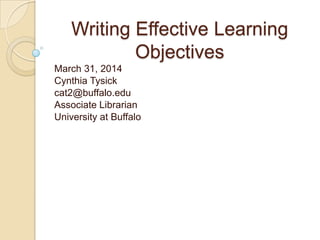
Write Effective Learning Objectives Using ABCD Method and Bloom's Taxonomy
- 1. Writing Effective Learning Objectives March 31, 2014 Cynthia Tysick cat2@buffalo.edu Associate Librarian University at Buffalo
- 2. What we’ll cover The goal(s) of learning objectives An introduction to the ABCD method for writing learning objectives An introduction to Bloom’s Taxonomy Evaluating your current learning objectives Identifying gaps in your current learning objectives based on the ACRL Information Literacy Standards Employing the ABCD method to rewrite your current learning objectives Constructing a lesson plan necessary to meet your revised learning objectives Creating assessments that align with your revised learning objectives
- 3. Learning objectives… are not goals. Goals are general and non-specific, can be used for a course or curriculum. (e.g. “Create an information literate, lifelong learner.”) are written for units of study. guide the student to what they are expected to do after instruction. (e.g. “The student will distinguish academic scholarship from non-academic scholarship.”) Bonus: they help guide the lesson plan!
- 4. ABCD Method 4 components of a learning objective: ◦ A is the Audience (always the student) ◦ B is the behavior or action verb ◦ C is the condition for the objectives ◦ D is the degree of achievement or criteria
- 5. The action verb is the key! Action verb can’t be omitted ◦ Tells the student what they will do after instruction. (e.g. distinguish academic scholarship from non-academic scholarship) Benjamin Bloom and his colleague, David Krathwohl, created a taxonomy of verbs used to write effective and measureable learning objectives.
- 6. Bloom’s Taxonomy… describes and classifies observable knowledge, skills, attitudes, behaviors and abilities. runs under the assumption that there is cognitive activity happening in the brain. ◦ Levels of observable action ◦ Three domains: cognitive (thinking), affective (attitudes), and psychomotor (doing) is commonly in the cognitive domain.
- 7. Cognitive Domain Level 1: remember (knowledge) & understand (comprehension) Level II: apply (application) & analyze (analysis) Level III: evaluate (evaluation) and create (synthesis) Each level demonstrates a progression of critical thinking skills.
- 9. See the handouts Critical thinking is developed as you go up the levels. Creating has replaced synthesizing. Creating new knowledge is the ultimate objective.
- 10. Putting it all together After the lecture the student will distinguish academic scholarship from non-academic scholarship. Lesson: PowerPoint defining academic scholarship, identifying authors of academic scholarship, and going over the sections of an academic article. Assessment: Show the covers and citations to a popular magazine piece and a journal article. Students distinguish one from the other using clicker or clicker app.
- 11. Evaluating your current learning objectives Group exercise
- 12. Evaluating your current learning objectives The student will be able to understand the information cycle.
- 13. Evaluating your current learning objectives The student will be able to understand the information cycle. What’s the verb here? Using the two handouts can you come up with a more descriptive verb?
- 14. Evaluating your current learning objectives Work on finding a good verb for your learning objective.
- 15. ACRL Info. Lit. Standards Determine the extent of information needed Access the needed information effectively and efficiently Evaluate information and its sources critically Incorporate selected information into one’s knowledge base Use information effectively to accomplish a specific purpose Understand the economic, legal, and social issues surrounding the use of information, and access and use information ethically and legally
- 16. ACRL Info. Lit. Standards Group Exercise
- 17. ACRL Info. Lit. Standards The student will create a search strategy.
- 18. ACRL Info. Lit. Standards The student will create a search strategy. Standard 2: Access the needed information effectively and efficiently. Can you use a more descriptive verb that aligns with this ACRL standard?
- 19. ACRL Info. Lit. Standards Can you identify a learning objective that needs work aligning with ACRL Info. Lit. Standards?
- 20. ABCD Method A=Audience (student) B=Behavior w/action verb C=Condition ◦ after attending a lecture. . . . ◦ following review of a demonstration. . . . ◦ given a case study. . . . ◦ after completing the assignment. . . . ◦ given a specific instrument. . . D=Degree ◦ How well the learner must perform (can be omitted if there is no deviation from normal protocol)
- 21. ABCD Method Order ◦ Condition ◦ Audience ◦ Behavior w/action verb ◦ D (if necessary) Within a given time frame Within a give number of tries Criteria set by instructor Tense is always future (e.g. will)
- 23. ABCD Method The student will construct a search strategy.
- 24. ABCD Method The student will construct a search strategy. Use the ABCD method to create a more measureable learning objective.
- 25. ABCD Method Use the ABCD method to make your learning objective more measureable.
- 26. Lesson Plans What will you need to cover in order for the student to be able to do what you want them to do? What is the most effective way to get your lesson across? ◦ Demonstration? ◦ Lecture? ◦ Hands-on? ◦ Flipped? What materials will you need to create? ◦ Search examples for a demo? ◦ PowerPoint or Prezi? ◦ Checklist or worksheet? ◦ Video or PowerPoint with audio?
- 27. Lesson Plans Create an outline for a lesson that meets your learning objective? Delivery method Resources needed
- 28. Assessment Some of the more common assessments are: ◦ Completed handout ◦ Post-survey ◦ Quiz ◦ Response paper ◦ Presentation/demonstration ◦ Bibliography ◦ Faculty feedback
- 29. Assessment How will you assess the learning objective has been met?
- 30. Resources Writing Instruction Objectives by Kathy Waller, http://www.naacls.org/docs/announcement/wr iting-objectives.pdf Bloom’s Taxonomy of Measureable Verbs by Jerry Dugan, http://www.taasa.org/wp- content/uploads/2012/04/Working-on-the- Wow-Side-Handout-31.pdf ASSURE model for designing instruction by Jerry Dugan, http://taasa.org/wp- content/uploads/2012/04/Working-on-the- Wow-Side-Handout-11.pdf Bloomin’ Apps by Kathy Schrock, http://www.schrockguide.net/bloomin- apps.html